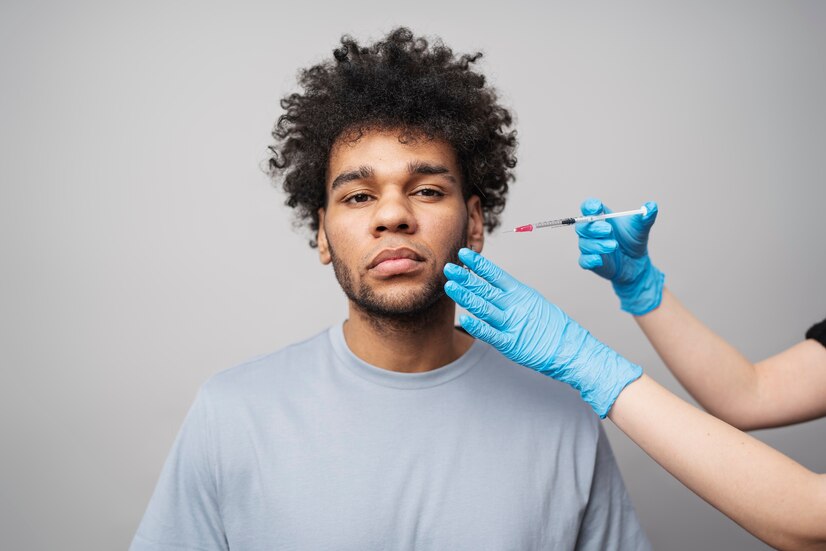Botox for TMJ: Process, Costs and More


Temporomandibular joint (TMJ) disorders affect the jaw's muscles and joint, resulting in pain and dysfunction. TMJ problems affect an estimated 10 million Americans, according to data from the National Institute of Dental and Craniofacial Research.
Common symptoms of TMJ disorders include pain, restricted range of motion, or abnormal jaw movements. Moreover, untreated TMJ problems frequently make it impossible to carry out even basic daily functions like chewing or speaking. Physical therapy, surgery, night guards, and other mouth appliances have all been used as traditional therapies for these issues; more recently, Botox has emerged as a promising alternative.
The main benefit of Botox, also called Botulinum Toxin type A, is that it can reduce wrinkles and delay the ageing process. Beneath its aesthetic appeal, however, is a fascinating potential for pain treatment in a range of neurological conditions, including cerebral palsy, migraines, and, it seems, malfunction of the temporal lobe of the jaw.
Dr. Charles Soparkar, an ophthalmologist and scientist at Texas University, states that "botulinum toxin type A (BOTOX) acts directly on overactive nerves/muscles to inhibit their activity." This may contribute to the explanation of why botox injections cause the TMJ symptoms around the affected areas to disappear.
Botox is a popular choice for treating mild-to-moderate degrees of simple mechanical (TMJ disc displacement without reduction, for example) rather than inflammatory (rheumatoid arthritis, for example) related temporomandibular disorders, which would require a more involved approach. The preference for non-surgical treatments has increased, and the procedure time (usually less than 30 minutes) makes botox an appealing option.
The precise cost of treating TMJ issues alone is unknown, however a single botox injection normally runs about £300 and £450 for men and between £275 and £350 for women. When making treatment options, prospective patients should be aware that the procedure could need to be repeated based on individual requirements.
Despite promising outcomes, the FDA has not yet legally approved the use of Botox for temporomandibular problems. But the future seems bright, considering the favourable results many practitioners around the world have observed. To ascertain the long-term effects and overall efficacy of Botox, however, further comprehensive clinical trials are still required.
Temporomandibular Joint (TMJ) disorders signify a set of uncomfortable, often painful conditions affecting the jaw joint and muscles controlling its movement. You can open and close your lips as well as slide it from left to right or vice versa thanks to this intricate mechanism, which is situated on each side of your head just in front of your ears. One of the most prevalent age-independent risk factors for TMJ disorders is stress, which is also associated with bruxism, or the unintended clenching and grinding of teeth. Additional prevalent risk factors encompass dental misalignment leading to an incorrect bite, temporomandibular joint-affecting arthritis, and any trauma or injury affecting the jaw joints.
Symptoms of TMJ disorders include excruciating facial pain that can affect one or both sides and at times may spread to the neck, tension type headaches which are usually non specific in nature, and small migraines that are caused by overworked jaw muscles that are trying to keep the lower jaw (mandible) in a comfortable resting position. The primary complaints include jaw locking, clicking, and popping sounds occurring during routine oral movements, as well as occasionally having trouble opening the mouth wide or yawning.
One option of treatment is physical therapy, and this uses methods to increase muscular flexibility around injured areas and combine it with strengthening exercises, is essential to many treatment strategies since it speeds up the recovery of normal function. Non-steroidal anti-inflammatory drugs (NSAIDs, such as ibuprofen) may be prescribed for a short while in order to provide instant relief, but they shouldn't be used long-term due to the possibility of organ damage unless specifically advised differently.
Oral splints, often known as mouthguards, when worn overnight assist in minimising the amount of pressure that is unintentionally applied to teeth, hence reducing issues over time. Although it doesn't immediately treat the condition, it is crucial for protecting teeth and supporting structures from unnecessary wear and strain. It also improves sleep quality by reducing the likelihood of unintentional nocturnal bruxism.
The protein commonly referred to as botox, or botulinum toxin, originates from the bacteria Clostridium botulinum. Known as a neurotoxic, its primary action is to cause controlled muscular relaxation by briefly obstructing nerve-muscle transmission.
Upon injection into the muscle tissues, Botox inhibits the neurotransmitters responsible for controlling muscular contractions. The effects gradually fade after a few months due to natural healing processes.
Botox is utilised for more than just cosmetic wrinkle reduction; it is also used to treat medical conditions including chronic migraines. When injected around the head and neck, it minimises headache days. Numerous ailments are improved by it, such as resistant overactive bladder cases, primary hyperhidrosis (excessive sweating), cerebral palsy, stroke, and stiffness in the muscles.
Discovering the therapeutic potential of Botulinum Toxin type A for Temporomandibular Joint (TMJ) diseases goes beyond its use as a cosmetic treatment. Its basic working principle is to relax and release tension in the target muscles by obstructing the nerve signals that cause the muscles to contract.
When applied directly to the overworked and tense jaw muscles, most notably the masseter, a major player in the elevation of the mandible during chewing, and the temporalis, another player supporting a similar function along with retrusion, or pulling back the lower jaw, it significantly reduces the involuntary clenching or grinding activity that is often associated with TMJ disorders.
According to Texas University biochemist and ophthalmologist Dr. Charles Soparkar, "Botulinum toxin type A (BOTOX) acts specifically on hyperactive nerves/muscles to inhibit their unnecessary activity."
Botox typically provides an added benefit when used locally and doesn't have systemic negative effects because it cures problems that only affect a specific location.
Benefits extend beyond ease of discomfort. Reducing overly tight muscles improves performance in general by decreasing inflammation, which is often caused by persistent overload. This makes it possible to open the mouth comfortably and freely, two things that may not have been possible in the past.
Less propensity for inadvertent nighttime bruxism also protects teeth from unexpected wear and tear over time, potentially averting the formation of permanently sensitive teeth—a related outcome. Consequently, after treatment, patients report a significant overall improvement in their quality of life, which makes botox an invaluable addition to the available therapeutic choices for TMJ disorders.
Before the initiation of botox therapy for TMJ a comprehensive examination and evaluation is needed at first. After a thorough clinical examination is done pertinent medical history including neuromuscular disease or pregnancy is taken and also any required radiographs guarantee an accurate assessment of a patient's health. People who are known to be allergic to botulinum toxin or who get infections at authorised injection sites should exercise extra caution.
You will have a candid discussion with your health care provider about the anticipated outcomes of the procedure and any possible risk prior to the operation. This will help to lessen worry since reasonable expectations are already set up in advance. Anticoagulant drugs need to be avoided a few days prior to the procedure since they have the tendency to raise the possibility of bruising thereafter.
The injections are done by experts to guarantee that the proper amount and location are used to enhance benefits and limit side effects. Botox injections are usually administered into the masseter, the strongest muscle in the jaw, the temporalis, which is fan-shaped on both sides and aids in closing the mouth, and occasionally the pterygoid muscle, which permits sideways movement, using standard cosmetic needle sizes, such as 30-gauge.
The severity is one of the factors that determine the dosage. However, it is indicated that 25–100 units per therapy session is typical; nonetheless, this can vary depending on the circumstances. Since the botox provider carefully marks the locations with a white pencil, avoiding blood vessels whenever possible, the actual botox delivery is painless.
It is recommended to limit the number of heavy, chewable meals for the first few hours following surgery and to avoid lying down immediately after the procedure to reduce the possibility that the injected solution would affect undesired areas.
Resuming regular activities almost immediately is made feasible by minimal downtime; but, the benefits require time to manifest themselves, sometimes up to two weeks.
While most patients saw significant discomfort relief, there may be modest, transient side effects, like bruising or swelling near the injection site. Dosage titration remains crucial even if few reported trouble swallowing or markedly changed facial expressions, especially in first-timers. Systemic effects like fatigue and dry mouth have sporadically been reported.
The cost of receiving Botox for TMJ therapy varies depending on the recipient's gender, according to Dermaskin. Men are required to pay between £300 and £450, while women are required to pay a somewhat lesser amount between £275 and £350. The primary factors influencing this price variance are gender-specific variations in muscle mass, which have an effect on the total number of units required and, ultimately, total expenditure.
Patients thinking about using this therapy approach should understand that these are estimates, not set sums, but rather a range that provides an idea of the potential financial outlay that may be expected. This holds true even in the absence of insurance-related issues. When considering botox therapy, it is vital that consultations not only focus on clinical aspects but also address the expected costs involved. This will guarantee that patients are content with their post-treatment routine in a realistic manner and assist them in making an informed selection. There is transparency throughout the whole undertaking.
For Temporomandibular Joint (TMJ) problems, the effects of Botox therapy are temporary; most patients see noticeable improvements after three to four months.
Because TMJ problems can range widely in severity, individual patients may need different frequency therapy. Some people have recurrent or worsening symptoms after the initial effects of Botox wear off, necessitating additional injections every few months. By keeping the muscles surrounding the troublesome area relaxed, this therapy minimises undue strain on the jaw joint's structure and provides ongoing relief and prevention against future flare-ups.
Post-treatment sensations are typically not harsh because the procedure is less invasive. As a result, the treating clinician frequently advocates returning to regular functionality shortly following the session. While some minor discomfort or soreness around the injection site is common, this normally goes away without any assistance in a few hours or days. However, immediate medical intervention is required for a timely diagnosis and treatment if adverse effects increase or persist.
Botox therapy for temporomandibular joints (TMJ) is not without risk and significant side effects. Although these are uncommon in most cases, it's important to be aware of them:
Complications that are more severe but less frequent include:
Patients can reduce possible dangers by carefully choosing a medical professional with experience who is knowledgeable about this particular use of Botox. It is essential to understand the complex anatomy, particularly the nerves and veins surrounding the temporomandibular joint, in order to administer botox safely.
Additionally, open discussion regarding the patient's whole medical history with the practitioner helps prevent unanticipated drug interactions or reactions, guaranteeing a positive outcome.
Trauma or stress can cause temporomandibular joint (TMJ) disorders that make it difficult to move the jaw. The symptoms can include anything from jaw pain to facial pain. Conventional treatment includes physical therapy as well as the use of mouthguards and other oral appliances.
Due to its ability to block nerve and muscle activation, Botox has emerged as a promising treatment for TMJ pain. An injection of Botox typically costs between £300 and £450 for men and between £275 and £350 for women. Currently, this element cannot be approved by the FDA because significant trials are required to demonstrate long-term effects.
Although adverse effects are rare with any medical procedure, Botox injections are generally safe. The most frequent ones are weakness or transient bruising near the injection site. Serious cases with uneven facial motions or trouble swallowing have also been described, but these are rare. This highlights how crucial it is to choose skilled medical professionals in order to guarantee better overall results even in the face of difficulties managing such complicated illnesses.
The cost of Botox for TMJ problems varies significantly based on the location, practitioner competence level, and quantity needed. The average cost of a single botox injection according to Dermaskin is between £300 and £450 for men and between £275 and £350 for women. However, the total cost rises proportionately if multiple injections are needed to effectively address TMJ problems.
The number of units required for an effective course of treatment will depend on the severity of the condition, each muscle's specific characteristics, and the patient's reaction pattern. In order to preserve safety, a professional in this field typically begins by injecting 25–50 units per target area. The dosage is then adjusted based on the patient's response in subsequent sessions. All prescribed maximum limit criteria are adhered to.
Numerous trials demonstrating notable improvements after treatment suggest that Botox may be an effective treatment for TMJ problems. Reduced pain intensity and better jaw functions are the main benefits of Botox; however, it is not a treatment that is suitable for everyone, as it does not "cure" the underlying cause of muscular overactivity.
The effects of Botox can last anywhere from three to six months, but after that time, its activity progressively decreases and touch-up procedures become necessary to keep the desired results.








Plus get the inside scoop on our latest content and updates in our monthly newsletter.